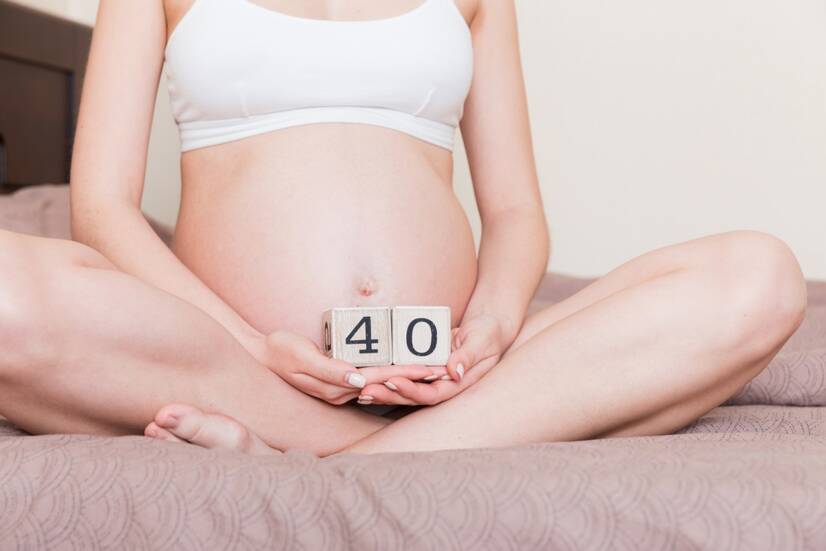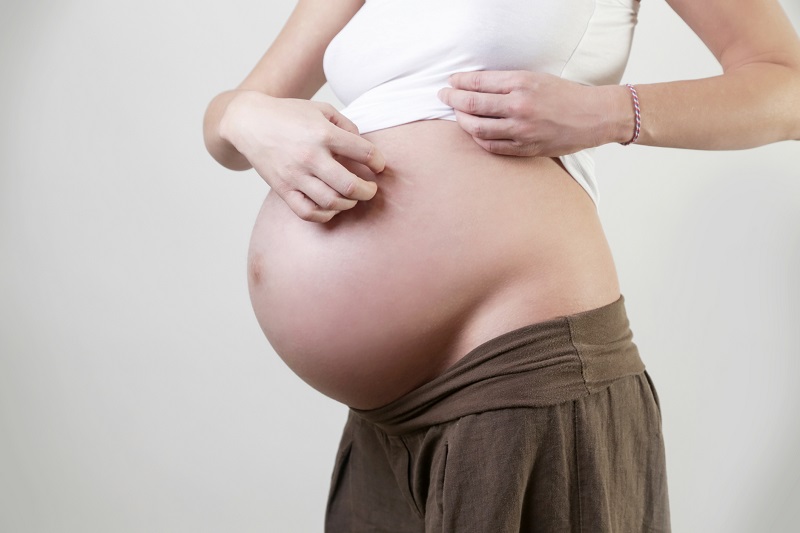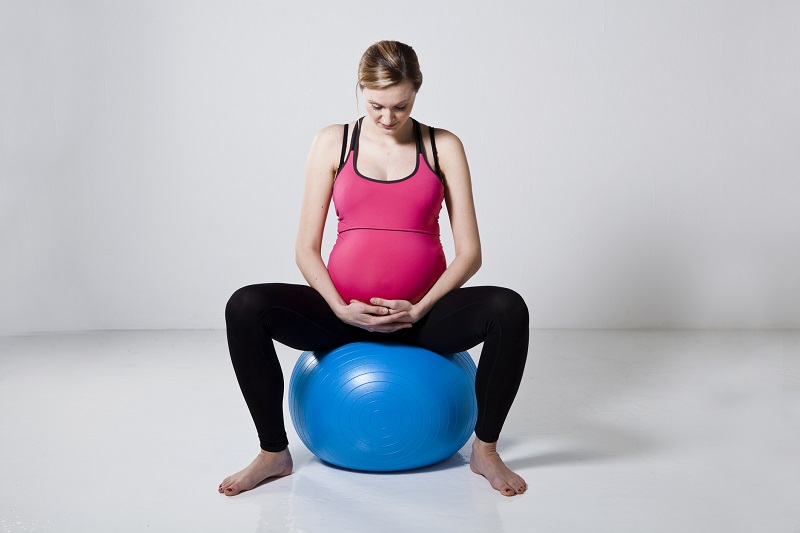- Modern obstetrics: 2nd, revised and expanded edition.
- nhs.uk - A week-by-week guide to pregnancy
- whattoexpect.com - 40th week of pregnancy
- babycenter.com - 40th week of pregnancy
40th week of pregnancy: is it time to give birth? + 41st and 42nd week of pregnancy

At 40 weeks, you are at the end of your pregnancy. The day of birth is approaching. You will soon meet your baby. Despite the difficult and sometimes arduous journey, it will be an adventure for you. After all, a little human being will be born.
Article content
Your baby is delivered and ready to be born.
It's almost unbelievable how quickly a perfect human being can develop during 38-40 weeks. Only 5% of women give birth at a given calculated term and up to 30% of pregnancies continue past the 40th week. Your body knows best when to give birth.
If your baby hasn't been born yet, by all accounts the birth will happen in the next few days.
How is the baby doing in the womb?
Your baby is ready for life outside the womb. It is fully developed and carried.
It weighs approximately 3460 g and measures 51 cm.
Although it is quite compressed in the womb because of the lack of space, it should still be active. You should feel its movements, despite the confined space and changes in its activity.
If this happens, it may be an important sign that something is wrong. If there are any changes, visit the nearest hospital.
Because the baby has stayed in the womb so far, it will probably have more hair and be clearer after birth.
Its brain will continue to develop at a rapid pace after birth, as will its skills and dexterity.
His fingernails are already sharp and longer, so he can scratch.
Some of your pregnancy hormones will also enter the fetus's body, so he will have swollen mammary glands and swollen genitals. This will adjust after birth.
The placenta is still nourishing the baby and providing him with the antibodies he will need to fight infections after birth for the first 6 months. Breastfeeding will provide the baby with even more antibodies to boost his immune system.
When the fetus is fully ready, it begins to produce the hormone estrogen. Estrogen triggers uterine contractions.
After the 40th week, the vernix, which has moisturized and protected the skin until now, leaves the baby's skin. Thus, the baby may develop drier skin in places after birth.
The table shows the approximate dimensions of the fetus at 40 weeks according to sonographic measurements
| Total length | Weight | HC Head circumference | BPD Transverse diameter of the head | AC Abdominal circumference | FL Femur length |
| 51.2 cm | 3460 g | 334 mm | 94.9 mm | 349,8 mm | 72,1 mm |
For more information on fetal size, see the article: ultrasound in pregnancy: fetal size, what is fetal biometry?
How does a woman feel at 40 weeks?
Your weight is the same. You may also notice a small weight loss.
You feel large, clumsy and uncomfortable because of the large pregnant belly.
You are now experiencing quite a lot of pregnancy fatigue. However, you may feel homesick after giving birth.
Common symptoms accompanying the last weeks of pregnancy include:
The oncoming messenger contractions, called Braxton-Hicks contractions. They occur more frequently and with greater intensity.
Fatigue and difficulty sleeping, which have also been with you for most of your pregnancy.
Stretch marks may continue to form, especially on your breasts, which are prepared for breastfeeding by the sucking of breast milk.
Your breasts are sore and full, ready for breastfeeding. You may notice that colostrum is dripping from your nipples. This appears as wet patches on your bra in the nipple area.
Swollen and bleeding gums often bleed even after gentle brushing.
Itchy skin, especially on the abdomen. Because of the tightening and drying of the skin, you often feel uncomfortable itching. Apply creams regularly to your skin to moisturise it and relieve the discomfort.

Pain on the side of the abdomen is caused by the enlarging uterus and its pressure.
Headaches. Try to drink and lie down. Sometimes the pain is caused by lack of fluids and fatigue. If you experience persistent severe headaches, visit a hospital.
Back pain from increasing strain on the spine is common. Stronger back pain also occurs before childbirth, when your body is preparing for delivery.
You may feel pain in the vaginal area caused by the pressure of the baby's head on your pelvis.
Indigestion and heartburn occur.
Bloating, constipation and the subsequent appearance of uncomfortable hemorrhoids arise due to pressure on the pelvis and pressure on the stool.
Cramps in the legs occur mainly at night.
Hot flashes are caused by pregnancy hormones.
Dizziness and light-headedness. Try taking a drink, lying down and elevating your legs. If that doesn't help, lie on your left side. This will relax the blood flow through the inferior vena cava and help the brain to get better blood flow, which helps to relieve the dizziness.
Your arms and legs may swell, so rest with your feet up.
Infections are common in the last month of pregnancy. Your body is weakened, stressed, immunity is lowered. This increases the risk of infections.
Urinary infections are common in the last month of pregnancy. They are manifested by burning during and after urination, pain in the bladder.
Vaginal infections are accompanied by itching, burning and discomfort in the genital area. They are manifested by a change in the consistency or smell of vaginal discharge.
If you suffer from an infection, it is necessary to visit a gynaecologist. He will prescribe you gentle medication to relieve and treat the infection.
Darker skin on the face or brown spots are called chloasma or pregnancy mask. Most dark spots disappear on their own after childbirth.
Your skin is more oily.
Your hair is thicker and shinier. You can thank pregnancy hormones for that.
Pelvic pain is caused by the uterus dropping into the pelvis and the subsequent pressure on it.
For a change from constipation, diarrhea may occur before the onset of labor.
Symptoms from previous weeks caused by pregnancy hormones persist, such as mood changes, morning sickness, increased sense of smell.
Thevaginal discharge should be white, milky, sometimes tinged pink. The pink coloration of the discharge is caused by the rupture of the delicate blood vessels of the cervix, which dilates and prepares for childbirth.
Although you won't feel it, the cervix opens and thins during this week.
Increased vaginal discharge is a sign of preparation for childbirth.
You may notice the mucus plug oozing onto your panties as a thicker discharge of greater quantity with a pink or brownish tinge. The passing of the mucus plug in the last week of pregnancy signals that labor is approaching and will probably take place in the next few hours or days.
The uncomfortable feeling of wet panties may be due to spontaneous leakage of urine due to the baby's pressure on the bladder. It may also be due to slow leakage of amniotic fluid.
Amniotic fluid leakage or urine leakage? How do I know?
| Amniotic fluid | Urine |
| is a colourless, odourless fluid that may have a sweet smell. Amniotic fluid cannot be stopped by contracting the pelvic muscles as in urination. | It has a yellowish colour and a specific smell. It stops when the pelvic muscles contract. |
You may also be surprised by the sudden drainage of amniotic fluid. So wear a sanitary napkin to be on the safe side. It will catch at least some of it and you'll reduce the unpleasantness of wet clothes and the puddle underneath.
If your amniotic fluid drains green or brown in colour, visit the nearest hospital immediately. It may be a sign that your baby has already had its first stool in the womb and needs to be born as soon as possible.
Pay attention to all the signs of labour starting. Give yourself plenty of rest to build up your strength for labour.
Carrying a pregnancy also carries its own risks. The longer the baby is in the womb, the more it grows and gains weight.
That's why check-ups in the consulting room are important. The fetus is checked and a sonographer determines the likely size of the baby. When carrying, larger babies are born and there is a risk of a more difficult birth through a narrow birth canal.
What investigations do I need to have at 40 weeks and at transfer?
Attend regular check-ups at the antenatal clinic that you are used to. Know what to expect during these. It is common for your doctor to recommend that you visit the antenatal clinic every other day.
After the 40th week after the transfer, most expectant mothers are admitted to hospital. At the hospital, she is checked and monitored regularly to ensure that the baby is not at risk. If necessary, labour can also be induced artificially.
If all is well, a CTG (cardiotocography) is performed every three days to record the fetal heart sounds and uterine contractions.
More common are vaginal examinations, which check whether the cervix is already opening and preparing for birth.
Sonography is used to check that the baby is well, to measure blood flow through the placenta to the fetus, to check the function of the placenta and to monitor amniotic fluid.
An oxytocin stress test is performed 10 days after the due date. Oxytocin is given and the readiness of the uterus and the condition of the placenta are monitored. After transfer 12 days after the due date, artificial induction of labour is often started.
Placental function decreases after the due date on days 10-12, which carries risks.
I'm 40 weeks pregnant, and there's no indication that labor will progress
It's possible your due date was miscalculated. It's not too late.
Should I deliver after my due date? When will my body decide to deliver the baby?
A calculated due date written down with a pen in your pregnancy book does not mean that the birth will actually take place on that day.
Up to 30% of pregnancies continue beyond the 40th week.
If the birth does not progress, your doctor will decide to terminate the pregnancy based on the tests and results.
41st week of pregnancy
You have your bag packed, your name picked out and still nothing is happening.
Try to be patient. Use the time to rest and plan for the future with your baby.
Going over your due date is not uncommon, even if it seems like forever.
42nd week of pregnancy
If, despite all the options to induce spontaneous labor, labor still hasn't occurred and your baby doesn't want to come out, your doctor will begin to induce labor artificially.
By rupturing the amniotic sac and then draining the amniotic fluid, administering medication to induce labor, or scheduling a cesarean section.
What are the possible ways to induce labour naturally?
If you have not yet given birth and do not even have a sense of impending labour, there are several suggestions to safely induce labour.
A fairly proven method is to increase physical activity. Try going for a longer walk, alternating brisk walking, taking the stairs, or start cleaning your home, mopping the floor, washing the bathroom. Do everything sensibly so you don't hurt yourself or the baby. When walking briskly, remember to breathe properly.
Although many couples do not even think about sex in the last weeks, intercourse is one of the ways to induce natural childbirth.
Sex releases oxytocin in the body, which induces labour. Orgasmic contractions stimulate uterine contractions. Sperm cramps are eased by sperm. They contain the hormone prostaglandin, which has an effect on the initiation of contractions. Gentle lovemaking is enough to induce labour.
Read also: Sex in pregnancy. What to watch out for and what changes does it bring?
Stimulation of the nipples produces the hormone oxytocin, also given to induce contractions. The best way is to gently squeeze the nipples between the index finger and thumb for a few minutes.
Run a hot shower over your abdomen and hips in circular motions. Be careful not to overdo it with the hot water, however. Choose a water temperature that you can tolerate and that you are comfortable with.
Exercises to induce labour. Examples of familiar exercises include the cat exercise. Get down on your knees, place your hands on the floor and rock from front to back.
Exercise on a fit ball. Sit on a fit ball, arch your back, spread your legs and just rock on it. This exercise will help the baby slide deeper into the birth canal.

Another option is to perform an enema. An enema will increase the movement of the cervix and help the uterus to contract. Do not use aggressive products when applying an enema, rather choose clean lukewarm water.
Spicy foods pass through the intestines and uterus and induce contractions. However, be careful not to have indigestion and unrelenting heartburn instead of contractions.
What is induced labour?
It is a birth that does not take place on its own, naturally. It is induced artificially, by the intervention of a gynaecologist and the administration of drugs that stimulate the contraction of the uterus.
The most common reason is carrying past the due date. It is recommended between the 41st and 42nd week of pregnancy. In case of risk or complications, even earlier.
Induction of labour is done in different ways in consultation with your gynaecologist.
Induction of labour with prostaglandin. Prostaglandin is a drug that promotes the maturation of the cervix. It makes the cervix shorter and softer. It helps the cervix to open and contractions to occur. The drug is given during a vaginal examination in hospital. Sometimes repeated administration of prostaglandin is necessary.
Artificial rupture of the amniotic sac is performed if your amniotic fluid has not yet drained. During a gentle vaginal examination, a small hole is made in the membranes. The hole allows the amniotic fluid to drain. The baby moves further into the pelvis. Its head is pressed against the cervix and the pressure stimulates contractions.
Oxytocin stimulates contractions. It is used when contractions have not occurred or are not increasing in intensity. It is administered by infusion into a vein, in small doses. The dose is gradually increased until regular contractions occur 3-4 times every 10 minutes. During induction with oxytocin, the baby's pulse must be monitored.
Planned caesarean section. If labour cannot be induced artificially or there is a risk of a large fetus and a risk of complications during labour, delivery is performed in the operating theatre by caesarean section.
What can we recommend?
- Walking is recommended, if your body can handle it. Exercise is also good for gaining strength to give birth.
- Practice breathing exercises.
- Eat healthy in smaller portions, several times a day.
- Talk to your baby. Ask your partner to talk to your tummy too. Baby will probably recognise the sound of your voices after birth.
- Shave safely or ask your partner to help you shave your private parts.
- Rest thoroughly, relax and get ready for the big day when your baby comes into the world.
Your bag is packed, your name is chosen. Just wait for the day your baby sees the light of day. You will finally see him, you will be able to really touch him and hold him in your arms.
The birth begins
If you feel irregular contractions starting at night, try to get as much rest or sleep as possible. You will need plenty of energy for the birth.
If the contractions occur during the day, stay upright. Move around actively. You will help the baby to move down and its pressure on the birth canal will open the cervix. This can speed the journey to birth.
Try different positions, swing on a fit ball or put your arms around your partner's neck and lean against them.
If your amniotic fluid has drained but you're still not having contractions, they're probably coming soon. Pack your things calmly, get your bag ready and head to the hospital.
If you have regular contractions and are still at home, it's time to pack your bag and go to the hospital.
A warm shower will help dull the pain a little.
Focus on breathing techniques. Take deep breaths in through your nose and out through your mouth.
Ask your partner for a massage and involve them in the birth. This will calm you down. Your body will produce more endorphins, which are natural painkillers.
Try to be calm and look forward to the arrival of the baby that is on the way.
Childbirth is divided into three stages:
- Phase 1 is contractions. Your cervix opens until it is dilated to 10 cm. The first phase lasts 6 to 12 hours. For some it is less, especially for second-born women.
- The stage is the birth of the baby.
- The stage is the birth of the placenta.
You can read more about the signs of labour and its process in our article .
What will your baby look like?
Your baby may not look the way you expect. After birth, babies are wet, have blood spots on their bodies, visible vernix, and postpartum signs that fade with time.
The baby's skull may not have a nice round shape. Passage through the birth can cause bruising to the head and can leave a cone-shaped head.
Lanugo, fine hairs covering the body, may still be visible.
The eyes are swollen, the hands and feet are discoloured blue.
White dots or rashes may be visible on the face.
His skin may be dry and peeling in places.
The breasts and genitals are swollen.
If it has been in utero longer, it may be born with longer hair and have more than 70 reflexes.
At first glance, a newborn may seem strange to you. However, these changes in appearance are normal. Over time, hours, days, these variations will adjust and your baby will be a beautiful newborn.
A newborn baby sees blurrily after birth. His central vision is yet to develop.

Gallery



Interesting resources
Related










